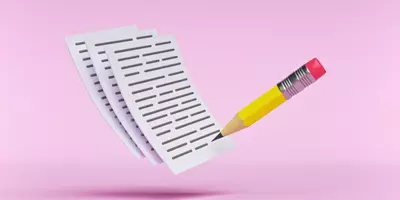
Dec 31, 2021 ● Kate Lopaze
Need the perfect cover letter? Follow these 6 rules
Cover letters may feel like a throwback to the now largely gone days of printing out your resume on fancy paper and sending it, but they’re still holding on as an important part of the job search process. They’re partly a formality, but you should really look at them as a chance to set the tone for your entire application package.
1. Think of the cover letter as your elevator pitch
The cover letter is your first chance to make an impression—and when you consider that the average hiring manager spends mere seconds skimming application materials, it could be your best chance to grab them. Think of the cover letter as your elevator pitch, or putting your best selling points in as few words as possible.
2. Find a creative opening
A cover letter is, well, a letter, but you should still think of it as a creative writing project. (More nonfiction than fiction, obviously!) The best place to be creative in your cover letter is right at the opening. You want to grab attention right away, and when someone has read fifteen “to whom it may concern” or “dear sir or madam” openings in a row, something that breaks that snoozefest streak is likely welcome. That doesn’t mean being too out-there for the sake of attention, but it’s the right place to mention if you have a very special qualification or a personal connection to the job or company to which you’re applying.
A sentence or two is fine here—no need to write long narrative paragraphs about how you’ve always dreamed of working for this particular company. But if you do have an anecdotal connection or something that makes you unique, now’s the time to bust it out.
3. Don't rehash your resume
The cover letter is basically an intro to your resume, so you don’t need to include all the bullet points that your resume will cover. What you should do instead is pick a few highlights that show your best qualifications and skills, and use a few sentences to describe why they make you a great fit for this opportunity.
The cover letter is great for providing context for your resume, which can be a huge help if your resume has gaps or other challenges that you want to explain. The cover letter helps you set the narrative for the reader, and spin your qualifications in the best possible way.
4. Keep it short and to the point
We’ve all got interesting stories to tell, but your cover letter isn’t the right place to get long-winded about it. A good cover letter has short paragraphs (just a few sentences, tops) and are broken into coherent, easy-to-follow topics. Remember how the reader only has seconds to decide if they’re going to move forward with you? If your cover letter looks like one solid brick of text, that makes that snap judgment a lot easier.
And even though email and digital reading formats have helped make the “one-page” rule less essential, it’s still a good rule of thumb to help you keep your cover letter lean, mean, and readable. If your cover letter runs more than a page and a half in a standard text editor, then it’s way too long and you need to edit it.
5. Maximize the keyword potential
In a world where the first eyes on a cover letter or resume is a digital screening system, keywords are your friend. Automated and AI systems are programmed to look for certain words and phrases to help push applications into a queue for further review. Industry-specific skills are a good place to start, but if you feel stuck as to what types of keywords you should include, look at the job description. Are there certifications required? Certain skills that jump out at you?
You don’t want to just regurgitate what’s in the job posting, but choosing a few key phrases can help get the attention of both human and digital readers who are looking for a preliminary hook.
6. Always edit and proofread
A cover letter might feel like an email, but don’t skimp on the formality here. You should treat it like a serious document, which means writing a draft, then reviewing it to make sure that it not only covers what you want to be covered but that you haven’t made any glaring mistakes. If you have a trusted friend or family member who can take the time, a second pair of eyes never hurts. They may see things you’ve glossed over, or be able to give you feedback about how your cover letter comes across.
Sloppy typos and mistakes can really undermine your application, so it’s best to take some extra time to make sure that your letter is everything it can be.
Your resume may be the star of the application package, but the cover letter is the opening act. And a bad opening act can ruin a whole show. The time and care you put into tailoring your cover letter now will make you look like an even better candidate, who puts thoughtful care and attention into whatever they do.


